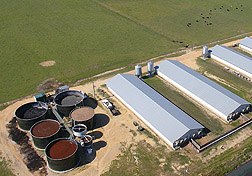
ARS scientists and cooperators have developed a
second-generation system that exceeds strict state environmental standards for
controlling pollutants from swine farms. Photo courtesy of Vistaaerials.com.
|

|
There’s Money in Managing Manure--When It’s Done Right
By Ann Perry
April 29, 2009 New and expanding swine production
facilities in North Carolina are required to use manure management systems that
meet the strictest environmental performance standards in the nation.
Fortunately, Agricultural Research
Service (ARS) scientists and cooperators have developed a system that
exceeds state benchmarks for controlling pollutants from swine farms.
Soil scientists
Matias
Vanotti and
Ariel
Szogi worked with Super Soil Systems USA of Clinton, N.C., to develop a
second-generation system that met North Carolina’s environmental
standards for manure management. As would be expected for new technologies,
significant cost reductions were achieved by innovations and on-farm testing.
The revamped system was two-thirds less expensive to build and operate than the
first-generation system, which was tested in 2003.
The two researchers work at the ARS
Coastal
Plains Soil, Water and Plant Research Center in Florence, S.C. For this
full-scale project, they collaborated with ARS microbiologist
Patricia
Millner at the agency’s
Environmental
Microbial and Food Safety Laboratory in Beltsville, Md., and ARS chemist
John
Loughrin at the agency’s
Animal
Waste Management Research Unit in Bowling Green, Ky.
The new on-farm treatment system used solid-liquid separation and nitrogen
and phosphorus removal processes. It removed high levels of several pollutants
from manure wastewater, including almost all of the pathogens, odor-causing
constituents and ammonia. Replacing anaerobic-lagoon-based systems with the new
technology also reduced greenhouse gas emissions by 97 percent.
Animal health and production also benefited. Swine daily weight gain
increased, feed conversion improved, animal mortality decreased and 5.6 percent
more hogs were sold per growing cycle.
Separated manure solids were converted in a centralized facility into
composted materials and used for organic plant fertilizer, soil amendments and
plant growth media. Producers can also profit from the new system by selling
greenhouse gas emission reduction credits and water quality credits.
The new technology could help swine-producing states protect existing jobs
and keep the door open for future job expansion. This technology was featured
in a chapter of “Manufacturing
Climate Solutions: Carbon-Reducing Technologies and U.S. Jobs,”
published in 2008 by Duke University’s Center on Globalization,
Governance & Competitiveness.
U.S. Patent Application Serial No. 11/820,396 was filed for this system on
June 19, 2007.
ARS is the principal intramural scientific research agency of the
U.S. Department of Agriculture.